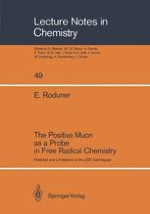1988 | OriginalPaper | Buchkapitel
Experiments employing muons
verfasst von : E. Roduner
Erschienen in: The Positive Muon as a Probe in Free Radical Chemistry
Verlag: Springer Berlin Heidelberg
Enthalten in: Professional Book Archive
Aktivieren Sie unsere intelligente Suche, um passende Fachinhalte oder Patente zu finden.
Wählen Sie Textabschnitte aus um mit Künstlicher Intelligenz passenden Patente zu finden. powered by
Markieren Sie Textabschnitte, um KI-gestützt weitere passende Inhalte zu finden. powered by
‘Natural’ muons are produced in the following way: light nuclei, mainly protons, from primary cosmic rays fall on the earth with high energy. In collisions with molecules in the upper atmosphere they interact with their nuclei and trigger the production of new particles. One of them, the positive pion, decays with a mean lifetime of 26 ns into a positive muon and a neutrino:(2.1)$$ {\pi ^{ + }} \to {\mu ^{ + }} + {\nu _{\mu }} $$ The pion is a spin-zero particle, but the neutrino has spin $$ \frac{1}{2} $$ with negative helicity, i.e. with its spin pointing in the direction opposite to its momentum in the centre-of-mass system. In order to conserve angular momentum the muon must also have spin $$ \frac{1}{2} $$ and negative helicity.
